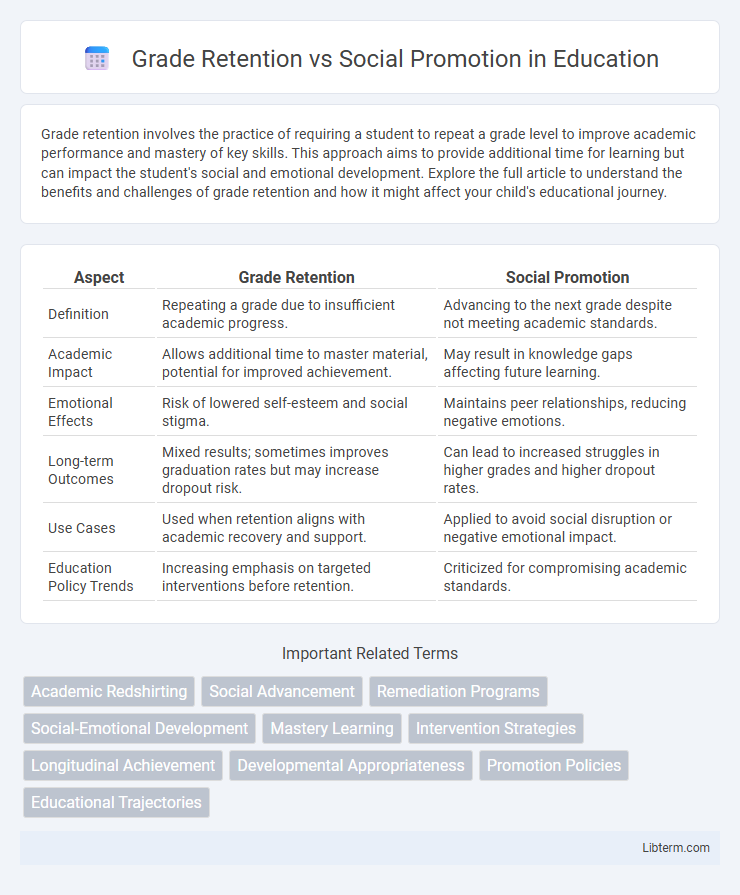Grade retention involves the practice of requiring a student to repeat a grade level to improve academic performance and mastery of key skills. This approach aims to provide additional time for learning but can impact the student's social and emotional development. Explore the full article to understand the benefits and challenges of grade retention and how it might affect your child's educational journey.
Table of Comparison
| Aspect | Grade Retention | Social Promotion |
|---|---|---|
| Definition | Repeating a grade due to insufficient academic progress. | Advancing to the next grade despite not meeting academic standards. |
| Academic Impact | Allows additional time to master material, potential for improved achievement. | May result in knowledge gaps affecting future learning. |
| Emotional Effects | Risk of lowered self-esteem and social stigma. | Maintains peer relationships, reducing negative emotions. |
| Long-term Outcomes | Mixed results; sometimes improves graduation rates but may increase dropout risk. | Can lead to increased struggles in higher grades and higher dropout rates. |
| Use Cases | Used when retention aligns with academic recovery and support. | Applied to avoid social disruption or negative emotional impact. |
| Education Policy Trends | Increasing emphasis on targeted interventions before retention. | Criticized for compromising academic standards. |
Understanding Grade Retention and Social Promotion
Grade retention involves having students repeat the same grade to improve academic skills, while social promotion advances students to the next grade regardless of mastery to maintain age-group peer alignment. Research highlights that grade retention can lead to short-term academic gains but may also increase dropout rates and affect self-esteem, whereas social promotion risks leaving students unprepared for higher-level coursework. Educators must weigh these outcomes to balance academic achievement with social and emotional development in policy decisions.
Historical Overview of Educational Promotion Practices
Educational promotion practices have evolved significantly since the early 20th century, with grade retention initially being a widespread method to ensure academic readiness. Social promotion gained traction mid-century as educators questioned the negative impacts of retention on student self-esteem and social development. Recent trends emphasize data-driven approaches, balancing retention and promotion to optimize academic and social outcomes based on individual student assessments.
Pros and Cons of Grade Retention
Grade retention offers the potential benefit of giving students additional time to master essential academic skills, which can improve long-term learning outcomes and self-confidence. However, research indicates that retained students often face higher dropout rates, increased behavioral problems, and negative impacts on social-emotional development compared to promoted peers. The effectiveness of grade retention largely depends on the quality of follow-up instruction and support services provided during the repeated year.
Pros and Cons of Social Promotion
Social promotion allows students to advance to the next grade regardless of their academic performance, which helps maintain self-esteem and social development by keeping them with their age peers. However, it can lead to gaps in learning, increasing the risk of future academic failure and higher dropout rates. Critics argue that social promotion may undermine educational standards by promoting students without mastering necessary skills.
Impact on Student Academic Achievement
Grade retention often leads to temporary academic improvement but increases the risk of long-term disengagement and lower self-esteem, negatively affecting student achievement. Social promotion aims to maintain peer group cohesion and self-confidence but may result in students progressing without mastering necessary skills, leading to gaps in academic knowledge. Research indicates that targeted interventions combined with individualized support yield better academic outcomes than either retention or automatic promotion.
Effects on Emotional and Social Development
Grade retention often leads to increased feelings of anxiety, low self-esteem, and social isolation among students as they experience repeated failure and stigma, hindering emotional development. Social promotion may preserve peer relationships and self-confidence but risks advancing students without mastery of essential skills, which can cause frustration and disengagement later. Both practices significantly impact emotional well-being and social integration, with retention posing greater challenges to long-term social development while social promotion may compromise academic and emotional growth.
Factors Influencing Retention and Promotion Decisions
Factors influencing grade retention and social promotion decisions include academic performance, behavioral assessments, and social-emotional development. Educators consider standardized test scores, classroom engagement, and peer relationships to determine if a student is ready to advance. School policies, parental input, and resource availability also significantly impact whether a student is retained or socially promoted.
Alternative Strategies to Retention and Promotion
Alternative strategies to grade retention and social promotion include targeted intervention programs, such as personalized tutoring and summer school, which address specific academic deficits without holding students back an entire year. Multi-tiered systems of support (MTSS) integrate continuous assessment and differentiated instruction to promote student growth while maintaining grade progression. Credit recovery options and competency-based learning allow students to demonstrate mastery before advancing, balancing academic standards with social-emotional development.
Role of Parents, Teachers, and Administrators
Parents, teachers, and administrators play critical roles in the debate over Grade Retention vs Social Promotion, each influencing student outcomes through their perspectives and interventions. Parents advocate for approaches that support their child's emotional and academic needs, often emphasizing personalized learning plans, while teachers provide firsthand insights on student readiness and development. Administrators balance policy implementation with the need for equitable educational practices, ensuring decisions reflect both academic standards and social-emotional well-being.
Policy Recommendations and Future Directions
Policy recommendations emphasize implementing evidence-based criteria for grade retention to minimize adverse effects on student achievement and socio-emotional development while promoting targeted interventions and support systems as alternatives. Future directions highlight the integration of personalized learning technologies and continuous assessment methods to tailor instructional approaches, reducing the necessity for retention or social promotion. Policymakers advocate for comprehensive professional development for educators to effectively address diverse learning needs and foster inclusive educational environments.
Grade Retention Infographic

 libterm.com
libterm.com